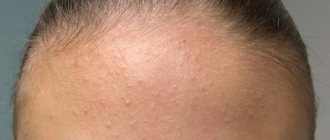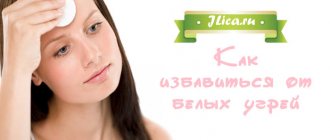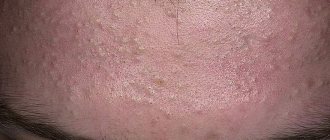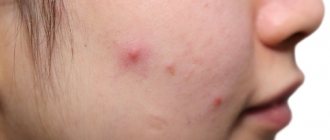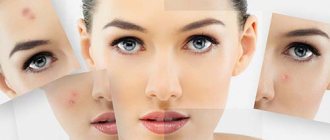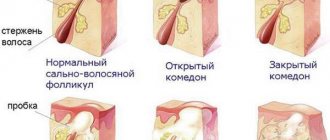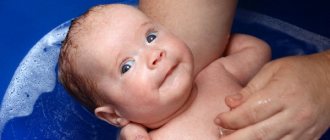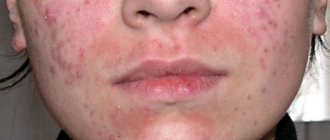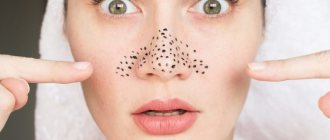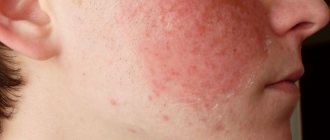Rashes appear at the age of 12 years and teenage acne goes away on average at 19-20. But some people develop a rash even after 20-30 years. Bad habits, stress at work and poor skin care contribute to the development of acne. People who take medications that affect the body's hormonal levels suffer from acne. To improve the condition, you need to contact a cosmetologist or endocrinologist.
At what age do acne appear in boys?
The first rashes are most often observed at 12-13 years of age. However, these are average figures. Acne in teenage boys can appear either at an earlier age or a little later. Everything here is individual and largely depends on the developmental characteristics of the body. In addition, the intensity of the spread of rashes can vary greatly: some young men have single acne, while others have numerous acne.
Teenage acne in boys - causes
Skin rashes are a manifestation of global processes occurring inside the body. Under the influence of chemical reactions, yesterday's boy turns into a man. However, acne on the face of a teenager is not the lot of all growing up representatives of the stronger half of humanity. Some people avoid this problem. Most teenagers are familiar with rashes firsthand.
Acne in a child can be caused by the following factors:
- Increased androgen levels, leading to changes in metabolism.
Under the influence of this factor, more subcutaneous fat is produced. In addition, its consistency changes (it becomes thicker). Increased secretion production leads to clogged pores. - Failure to comply with personal hygiene rules.
This may include touching your face or other areas of the skin with unwashed hands, sharing towels, and so on. All this contributes to the fact that pathogenic bacteria enter the clogged pore and provoke inflammation. The skin around the lesion turns red and begins to swell, and pus forms underneath it. The result is painful pimples. - Unbalanced diet.
Teenagers often like to indulge themselves with fast food, sweets, carbonated drinks and other unhealthy foods. Such adherence to unhealthy food negatively affects the body, including the condition of the skin. - Consequences of drug therapy.
More often, the problem occurs with long-term use of antibacterial or hormonal drugs. Such medications place a heavy load on the liver, which also affects the condition of the skin. - Increased stress associated with puberty can cause hormonal imbalance.
As a result, rashes form on the skin. - Demodecosis.
This is the result of the active action of the subcutaneous demodex mite. - Hereditary predisposition.
If one of the parents had strong activity of the sebaceous glands during adolescence, there is a high probability that the problem will arise in their son. - Unfavorable climatic conditions.
Cold wind, frost, scorching sun. All these factors have a negative impact on the condition of the skin.
Teenage acne on boys face
Acne can be caused by excess hygiene. Wanting to get rid of rashes, young men wash themselves with soap more often than required or wipe the problem area of the skin with alcohol lotion several times a day. All these manipulations only aggravate the situation. The skin becomes too dry, and in order to normalize the balance, the body secretes subcutaneous sebum more intensely. As a result, the child’s acne on the face will begin to increase in quantity, and all this will happen at lightning speed. In addition, the area of the rash will expand when the rash is squeezed out.
Teenage acne on boys back
At this age, the activity of the sebaceous and sweat glands is activated. More often, teenage acne on the back of boys appears when the rules of personal hygiene are violated: pathogenic microorganisms begin to actively operate, which is why a rash forms. In addition, improperly chosen clothing contributes to the appearance of rashes. The problem is often observed in those young men who prefer to wear underwear made of synthetic materials.
Salicylic acid
In order to cure pimples and blackheads in the shortest period of time, you can use products that contain salicylic acid. Any medication containing this substance should be applied pointwise, that is, only on the pimple without touching healthy skin.
These drugs should not be used without a doctor's prescription and without supervision. This may result in the release of even more subcutaneous sebum. This means there will be many times more acne.
When does acne go away in boys?
Since these rashes are known as adolescent rashes, the problem disappears as the young man grows older. In most cases, as you approach your 20s, they bother you less and less. However, even here the situation may vary. Some people experience rashes on the face and body at 30 and sometimes at 40 years of age. For this reason, when teenage acne in boys will go away is difficult to accurately predict. A protracted problem is a warning sign.
What is the difference
In adolescents of different sexes, the causes, types of acne and the disease process differ.
For girls
Almost 80% of the fair sex suffer from acne in their youth due to the menstrual cycle. A few days before the start of your period, acne begins to appear.
Diseases affecting the female part also contribute to the development of acne. Some medications for these diseases cause rashes.
Girls love to sunbathe, but in their youth, ultraviolet rays do not dry out acne, but contribute to excessive sebum production. Ultraviolet light destroys the skin's protective barrier and helps microorganisms spread even faster.
It is in girls that acne can appear due to excess weight. Boys are not susceptible to this. It is assumed that girls are more stressed because of this, so the problem lies in the nervous system.
In boys
It is believed that acne appears more often in young men. This is due to greater activity and testosterone production. Another important reason is genetic predisposition.
Growing facial hair can cause breakouts as bacteria accumulate in the hair follicles. It is convenient for them to reproduce with the help of a large amount of sebum.
While girls tend to watch their diet at least a little, boys mostly eat fast food. Harmful fats disrupt metabolism.
A teenager has acne on his face - what to do?
It is unrealistic to completely get rid of rashes in one day. However, if in the future the young man takes proper care of his skin and eats a balanced diet, this will reduce the likelihood of a problem occurring to a minimum. In severe cases, treatment of facial acne in teenagers should be carried out by a qualified professional. He will take into account the peculiarities of the inflammatory process and the general condition of the body, and only after that he will give his recommendations.
Cleansing acne skin
All treatment procedures must be carried out in a specialized office by an experienced dermatologist. Only if such conditions are met will therapy be considered as safe and highly effective as possible. The specialist knows exactly how to treat teenage acne in boys and will perform the entire procedure at the highest level. Hygienic cleaning of the skin can be carried out in the following ways:
- Using a vacuum
- special equipment is used for this. Removal of oil and dirt from the pores is carried out under pressure. - Ultrasonic exposure
- during the procedure, the doctor controls the depth of penetration of the miracle waves, which allows for high-quality removal of acne. - Laser cleaning
is an effective manipulation that allows you to influence the affected area. An additional advantage of this method is that during the procedure the possibility of burns is eliminated. As a result, there will be no charms or scars left on the skin.
At the same time, facial care is also important. How to wash your face properly to avoid acne:
- The water should not be too hot, since high temperatures activate the sebaceous glands. Cold is also not the most suitable option, as it does not cleanse the skin well. You need to wash your face with warm water.
- You can use soap no more than twice a week. It is desirable that it be tar.
- After washing with soap, your face should be rinsed with a decoction of chamomile or string.
- For drying, use a soft, clean towel. They need to blot their face. Do not rub or stretch the skin!
- If a young man has already started shaving, he should carefully wash off the remnants of the foam or gel used from his face.
How to eat if you have acne?
Before going on a therapeutic diet, you should definitely consult a doctor. The doctor knows how to treat teenage acne in boys, and how nutrition affects the condition of the skin. In addition, before prescribing a diet, he will prescribe the patient a comprehensive examination to rule out the presence of serious diseases of the endocrine or digestive systems.
How to get rid of acne for a teenager:
- Minimize your consumption or completely eliminate from your diet foods high in preservatives, dyes, sugar and salt.
Such components negatively affect the functioning of internal organs, which is why they cease to cope with their functions. Toxins begin to accumulate in the body. The skin partially takes over the function of removing them: as a result, it becomes covered with acne. - Maintain a drinking regime - drink at least 1.5-2 liters of water per day.
Only it helps cleanse the body of harmful compounds. Water cannot be replaced by tonics, teas, coffee, juices and other non-alcoholic drinks. - Enrich your diet with foods containing vitamins A, C, E and zinc.
Such substances have a positive effect on the skin. They are present in avocados, liver, mushrooms, nuts, legumes, green and yellow fruits. - Introduce foods that contain omega-3 fatty acids into your diet.
These substances have anti-inflammatory and antibacterial effects. They are found in nuts and seafood. - To regulate the functioning of the digestive tract, the diet must be enriched with liquid foods
(soups and broths).
Is it possible to press
Pimples can only be squeezed out by a cosmetologist in a sterile office. It can only crush blackheads or mature white pimples. Inflamed red pimples should not be touched. You can only help them mature.
Why you can’t squeeze pimples yourself:
- It will not be possible to make your hands, room, and cosmetics completely sterile;
- infection or dirt can get under the skin immediately;
- Squeezing one pimple can spread the infection throughout the entire face;
- If squeezed incorrectly, scars, marks, stains will remain for life, and even cosmetic procedures will not help remove them completely.
It is better to endure the unpleasant presence of acne until the end of treatment than to suffer with it for many years.
The Best Acne Remedies for Teens
In the fight against rashes, properly selected cosmetic and medicinal products for external use are effective. How to treat facial acne in teenagers depends on the severity of the problem. The following means can be used:
- lotions;
- tonics;
- gels;
- creams;
- ointments;
- masks.
Acne lotion for teenagers
The main purpose of such a product is a drying effect. However, comprehensive treatment of teenage acne in boys using lotions is impossible. To do this, you will have to add other drugs. Treatment of acne on the face in adolescents can be done with lotions:
- Preparations containing salicylic or boric acid.
More often, such solutions are low in cost, but they have a strong drying effect. - Tsindol
- this medicine is produced in the form of a suspension. The drug is based on zinc oxide. This product perfectly fights the inflammatory process, removes irritation, dries the skin and disinfects it. - Calamine
– relieves itching, dries the face, and creates a protective film on the surface. - Eriderm
- this lotion contains the antibiotic erythromycin. This substance has a healing and pronounced antimicrobial effect. - Zerkalin
– this drug contains the antibiotic clindamycin. This lotion can be used to care for dry and normal skin. - Chlorhexidine
is a drug that has a disinfectant effect. It should be applied only to the inflamed area and a limited number of times a day (no more than 3).
Acne cream for teenagers
The skin of young men is very sensitive, so special products must be used to combat rashes. A cream for acne on the face for teenagers should have anti-inflammatory, tonic, antiseptic and antiallergic effects. Many brands produce such products. As practice shows, acne in adolescents becomes significantly smaller with regular use of such cosmetics
- Clean line;
- Rosamet;
- Propeller;
- Differin;
- Face control.
Ointment for acne on the face for teenagers
Unlike cream, this healing product has a denser texture, so it takes longer to absorb. More often, the ointment is used to treat acne on the back of a teenager. In this case, drugs with antibacterial, cleansing and antiseptic effects may be prescribed. Here is the most commonly prescribed acne remedy for teenagers:
- Sulfuric ointment;
- Zenerite;
- Zinc ointment;
- Levomekol;
- Ichthyol ointment.
Acne masks for teenagers
These cosmetics are also very effective in combating rashes. Only an experienced dermatologist will give the best recommendations on how to treat teenage acne in boys. He will recommend only those remedies that are most effective. The following purchased masks will help remove teenage acne:
- Avene;
- Vitex;
- Dermacol;
- BioFresh.
Acne tablets for teenagers
The arsenal of modern medications used to combat rashes is large. The doctor knows how to treat teenage acne in growing boys. He will prescribe one of the following antibiotics:
- Tetracycline;
- Erythromycin;
- Minocycline;
- Clindamycin.
Probiotics can also be used in therapy. How to treat teenage acne in boys by normalizing microflora:
- Bifiform;
- Lactofiltrum.
Taking care of your skin correctly
The first thing a boy needs to learn at the age of 13 is to observe the rules of personal hygiene. In the morning and evening, it is recommended to use cosmetics that help get rid of oily shine, inflammation, and pore contamination. You can choose as you wish - foams, gels, creams and much more.
Washing your face twice a day will significantly improve your skin condition. But using this method alone will not solve the acne problem once and for all. Therefore, this procedure should be alternated with the use of masks and scrubs.
